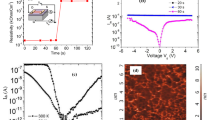Abstract
Heterostructures of graphene (G) or multilayer graphene (MLG) transferred on the graphene oxide (GO) printed layer are considered in the present study. Hillocks with a height of about 60–100 nm are found at the background GO relief of 10–15 nm. Graphene in these heterostructures completely follows the GO relief. The quasi-suspended layers on the hillocks are observed for MLG, and the distance between MLG and GO is estimated up to 20–40 nm. An increase in the MLG thickness is suggested to increase the distance between MLG and GO. Carrier mobility in G/GO heterostructures is found to equal 300–500 cm2/V s. The formation of quasi-suspended MLG/GO structures leads to an increase in the carrier mobility up to 4500 cm2/V s with an increase in the MLG thickness (3–8 nm). The change in the carrier mobility in MLG as a function of voltage sweep direction is also observed. The effect is supposedly connected with the ability of the quasi-suspended layer to corrugate under the gate voltage application. The capsulation of heterostructures using GO films leads to the carrier mobility degradation to 300–500 cm2/V s in one–four weeks. The quasi-suspended structures are promising for flexible and/or printed electronics at the use as graphene channels for sensors, detectors and other applications.





Similar content being viewed by others
References
Kamyshny A, Magdassi S (2014) Conductive nanomaterials for printed electronics. Small 10:3515–3535. doi:10.1002/smll.201303000
Italiano Istituto, di Tecnologia Graphene, Labs Capasso A, Del Rio Castillo AE et al (2015) Ink-jet printing of graphene for flexible electronics—an environment-friendly approach. Solid State Commun 224:53–63. doi:10.1016/j.ssc.2015.08.011
Li J, Lemme MC, Östling M (2014) Inkjet printing of 2D layered materials. ChemPhysChem 15:3427–3434. doi:10.1002/cphc.201402103
Li W, Li F, Li H et al (2016) Flexible circuits and soft actuators by printing assembly of graphene. ACS Appl Mater Interfaces 8:12369–12376. doi:10.1021/acsami.6b04235
Wang S, Ang PK, Wang Z et al (2010) High mobility, printable, and solution-processed graphene electronics. Nano Lett 10:92–98. doi:10.1021/nl9028736
Torrisi F, Hasan T, Wu W et al (2012) Inkjet-printed graphene electronics. ACS Nano 6:2992–3006. doi:10.1021/nn2044609
Soots RA, Yakimchuk EA, Nebogatikova NA et al (2016) Graphene suspensions for 2D printing. Tech Phys Lett 42:438–441. doi:10.1134/S1063785016040246
Li J, Ye F, Vaziri S et al (2013) Efficient inkjet printing of graphene. Adv Mater 25:3985–3992. doi:10.1002/adma.201300361
Su Y, Jia S, Du J et al (2015) Direct writing of graphene patterns and devices on graphene oxide films by inkjet reduction. Nano Res 8:3954–3962. doi:10.1007/s12274-015-0897-5
Lee SK, Jang HY, Jang S et al (2012) All graphene-based thin film transistors on flexible plastic substrates. Nano Lett 12:3472–3476. doi:10.1021/nl300948c
Standley B, Mendez A, Schmidgall E, Bockrath M (2012) Graphene-graphite oxide field-effect transistors. Nano Lett 12:1165–1169. doi:10.1021/nl2028415
Jewel MU, Siddiquee TA, Islam MR (2013) Flexible graphene field effect transistor with graphene oxide dielectric on polyimide substrate. In: 2013 International conference on electrical information and communication technology EICT 2013. doi:10.1109/EICT.2014.6777834
Hummers WS, Offeman RE (1958) Preparation of Graphitic Oxide. J Am Chem Soc 80:1339. doi:10.1021/ja01539a017
Antonova IV, Kotin IA, Popov VI et al (2016) Graphene-oxide films printed on rigid and flexible substrates for a wide spectrum of applications. Semiconductors 50:1065–1073. doi:10.1134/S1063782616080066
Antonova IV, Golod SV, Soots RA et al (2014) Comparison of various methods for transferring graphene and few layer graphene grown by chemical vapor deposition to an insulating SiO2/Si substrate. Semiconductors 48:804–808. doi:10.1134/S1063782614060049
Sidorov AN, Yazdanpanah MM, Jalilian R et al (2007) Electrostatic deposition of graphene. Nanotechnology 18:135301. doi:10.1088/0957-4484/18/13/135301
Bolotin KI, Sikes KJ, Jiang Z et al (2008) Ultrahigh electron mobility in suspended graphene. Solid State Commun 146:351–355. doi:10.1016/j.ssc.2008.02.024
Lv H, Wu H, Liu J et al (2013) High carrier mobility in suspended-channel graphene field effect transistors. Appl Phys Lett. doi:10.1063/1.4828835
Sojoudi H, Baltazar J, Tolbert LM et al (2012) Creating graphene p-n junctions using self-assembled monolayers. ACS Appl Mater Interfaces 4:4781–4786. doi:10.1021/am301138v
Pinto H, Markevich A (2014) Electronic and electrochemical doping of graphene by surface adsorbates. Beilstein J Nanotechnol 5:1842–1848. doi:10.3762/bjnano.5.195
Acknowledgements
The authors express their gratitude to Dr. S.A. Smagulova, Scientific Researcher of Ammosov North-Eastern Federal University, for providing the graphene oxide suspension. This study was financially supported by the Russian Science Foundation (Grant No. 15-12-00008).
Author information
Authors and Affiliations
Corresponding author
Rights and permissions
About this article
Cite this article
Antonova, I.V., Basyleva, E.V. & Kotin, I.A. High carrier mobility in quasi-suspended few-layer graphene on printed graphene oxide layers. J Mater Sci 52, 10230–10236 (2017). https://doi.org/10.1007/s10853-017-1186-3
Received:
Accepted:
Published:
Issue Date:
DOI: https://doi.org/10.1007/s10853-017-1186-3




